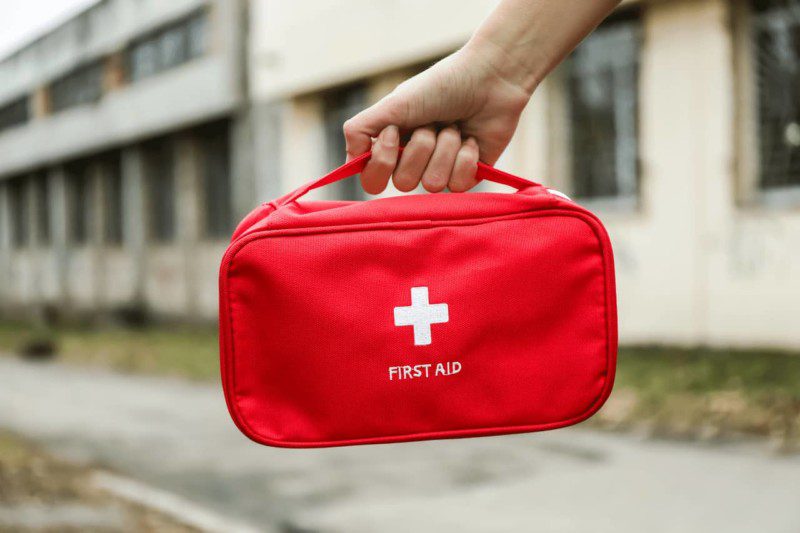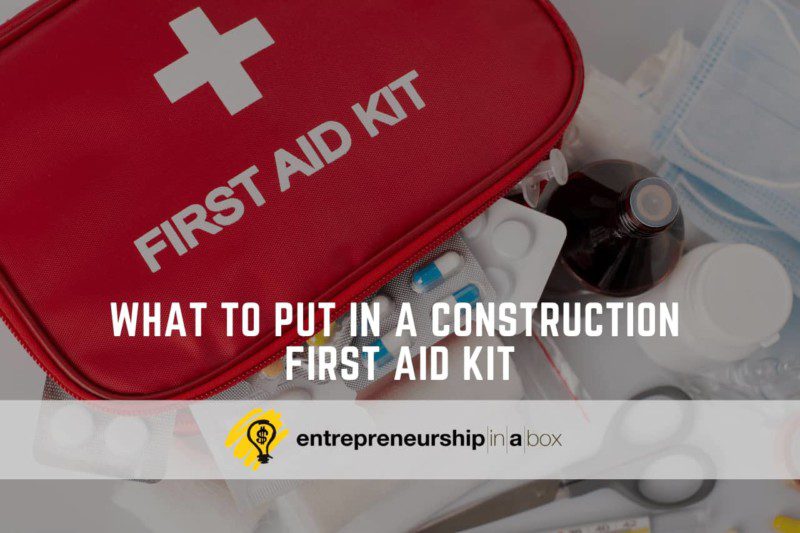In this article, we look at some of the essential components you should consider for your construction first aid course and what to pack in your first aid kit.
We can’t possibly cover every single thing you should include in a first aid kit in an article of this size but these are some of the essential items that should be considered at least, for every travel first aid kit and every trip you make.
Advice and guidance from a reputable first-aid training provider should also be considered when packing your kit.
What Type Of First Aid Bag Do You Need?
You can use anything to hold your first aid supplies, but there are a few things you should keep in mind:
- make sure that the size of the back is big enough to fit all the supplies you are going to carry
- ensure that the bag is set up in a way to sort the different products into different areas and compartments of the bag so you can quickly and easily find what you want
- you will want to make sure the bag is easy to carry from a practical perspective
- make sure the bag is waterproof, or at least water resistant, so the supplies inside do not get wet from rain or drink bottle leaks.
Quantities of First Aid Supplies
When packing a travel first aid kit, keep it minimal. The quantity of each supply you are going to take should be the minimum amount you would need to stabilize yourself in whatever way is required until you can get the appropriate medical attention or get to a pharmacy.
For example, with pain relief, you will only need to pack a few doses of pain relief, as you just need enough to make yourself comfortable while you seek out further assistance or try and locate a pharmacy so you can get relevant supplies.
Tailoring Your First Aid Kit
A lot of the travel first aid kits that you buy off the shelf will include a lot of gear that may not be suitable for your particular type of travel.
The best first aid kit for you is going to depend on where you are going, how long you’re going for, the type of activities you plan on doing, and the number of people in your traveling party.
As a result, there is no single travel first aid kit that is going to be perfect for all your different trips, and you may need to add and take things away depending on the nature of the trip you are about to embark on.
Things To Pack In Your Travel First Aid Kit
After Bite
After the bite is an ointment that you can put on mosquito bites (after you have been bitten) which reduces the itchiness to stop you from scratching the bites and turning them into open sores with scabs.
Blister Pads
Blister pads are not often thought of in first aid kits, but for a travel first aid kit, blister pads can be a lifesaver. There is nothing worse than being miles away from any form of medical assistance, being on foot, and developing blisters from your footwear.
Whether it was from a new pair of shoes or just walking for a long period, blisters can make the act of walking so excruciating that it’s almost unbearable.
Blister packs are absorbent pads you can place on blisters to put a buffer between the royal blister and the inside of your shoe, which stops the blister from getting any worse and provides a small amount of comfort.
Cold and Flu Medication
It is not uncommon to get a cold while traveling, especially after two-to-three weeks.
As a result, it is always good to carry a couple of doses of cold and flu medication.
You don’t want to carry a whole box, just a few doses, to minimize your symptoms while you seek further treatment or locate a pharmacy to get more.
Strepsils
Just like cold and flu medication, Strepsils can improve your comfort while traveling if you do end up with a sore throat.
You do not need a whole pack, just a strip, so you have a couple to keep you going until you can purchase an entire box somewhere on your travels.

Antihistamine
Whilst traveling, you may encounter things that trigger allergies that you don’t typically encounter at home.
Because of this, it is good to carry some antihistamines even if you don’t typically require them in your home environment.
They don’t take up much space, and they can make a big difference to your travel experience if you stumble across something that provokes an allergic reaction in you.
Ibuprofen
One of the most popular anti-inflammatory over-the-counter medications consumed across the world, ibuprofen is a must-have in your first aid kit.
This is one item where you may want to carry a whole box, or a significant quantity, given the number of different use cases ibuprofen has.
Mini Flashlight
Though a flashlight is not typically considered a piece of first aid equipment, a flashlight will make it possible for you to sort through and find first aid supplies you are looking for, if you need first aid supplies at night time.
Oral Electrolytes
If the weather of the country you are in has led you to become dehydrated due to either lack of available drinking water, strenuous exercise, or electrolytes is a very effective way of ensuring your health is stabilized until you can get access to an adequate amount of water.
Electrolytes are also very useful to help you stay hydrated if you get a stomach bug and end up vomiting or having diarrhea.
Band-Aids
It is always good to carry a selection of different Band-Aids in your first aid kit.
From different band-aid sizes that cover different sizes of wounds, through two Band-Aids that are more long-term than others.
In some cases, you might want something to cover a wound for the day until you get to your accommodation, whereas in other situations, you may need a bandaid that you can place over a wound that is waterproof and will last for a week while a wound heals.
Do not be conservative when it comes to filling your first aid kit with a generous selection of Band-Aids.
Band-Aids may also be a common request you get from other travelers who have not prepared appropriate first aid supplies for themselves.
Gauze Pads
For those wounds that require a dressing bigger than a band-aid, gauze pads and medical tape to strap the pads to your burn are a definite must-have.
Similar to Bandaids, ensure you have a variety of different size gauze pads, and also sterile and nonsterile gauze varieties.
Malaria Tablets
Malaria tablets will not be relevant in every travel first aid kit you prepare, but if you’re going to a country or a region where malaria is prevalent, then malaria tablets are a must-have.
If you catch malaria and you are not prepared, you will experience extreme discomfort and put your health at risk.
Emergency Survival Blanket
An emergency survival blanket is a special type of reflective material that can keep you very warm if you find yourself stranded in a very cold place or stranded overnight.



